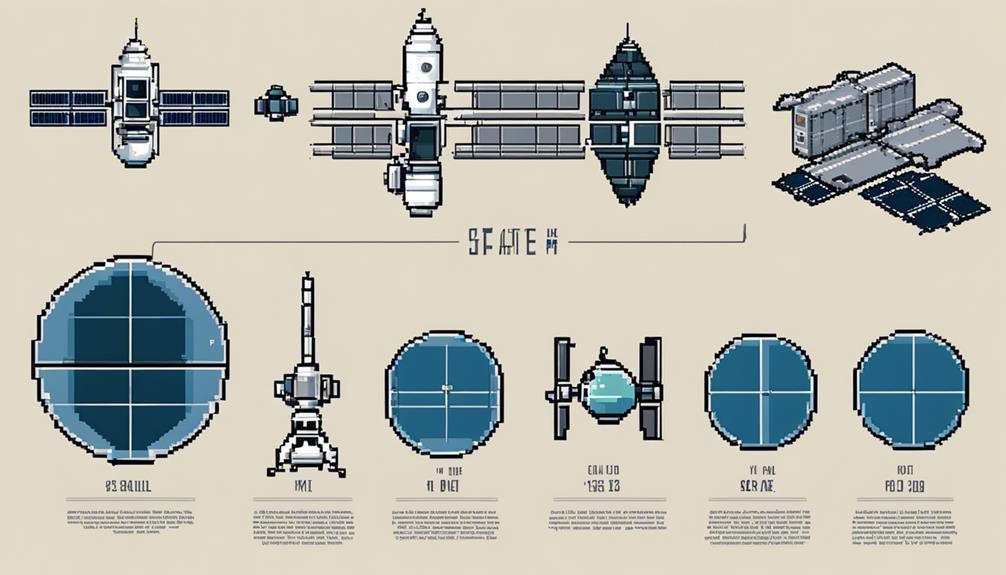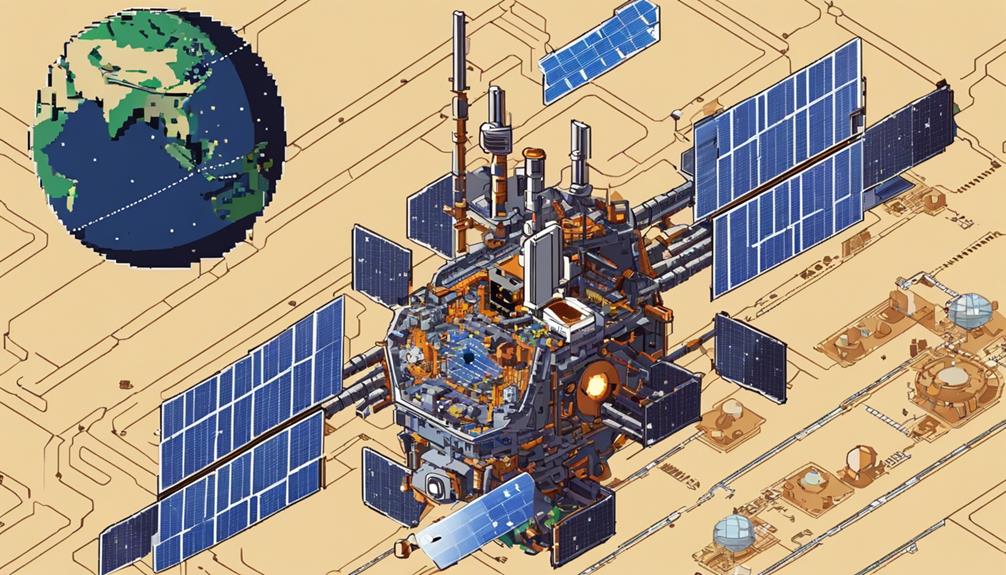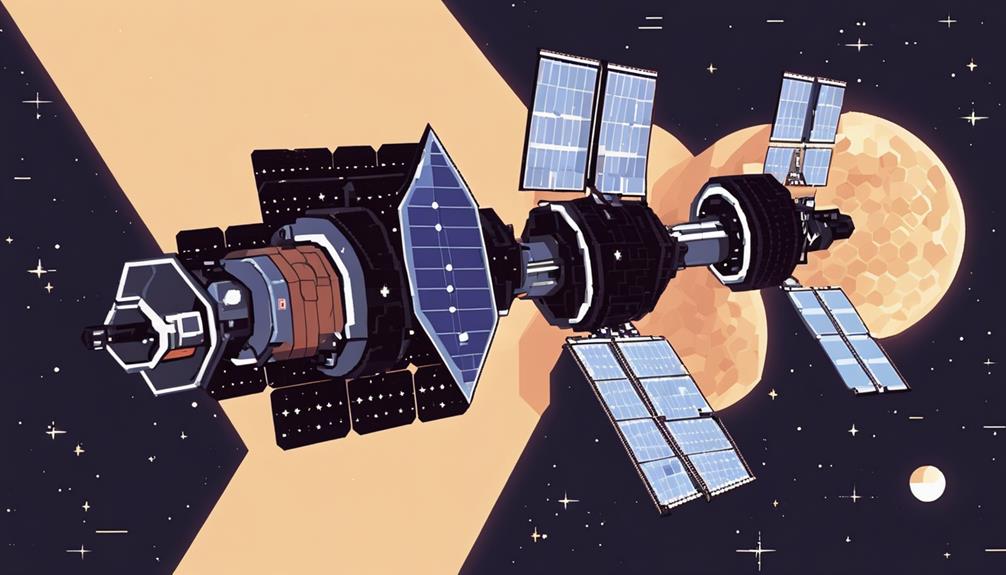The evolution of satellite miniaturization has fundamentally reshaped the landscape of space exploration, ushering in a new era of possibilities and efficiencies. The development of smaller satellites, such as CubeSats, has not only reduced the barriers to entry for space-based missions but has also catalyzed significant advancements in data transmission, remote sensing, and satellite longevity. By leveraging cutting-edge technologies like advanced propulsion systems, artificial intelligence, and additive manufacturing, the realm of satellite miniaturization continues to push the boundaries of what is achievable in space. These advancements hold the key to unlocking a future where space exploration is not only more accessible but also more sophisticated and impactful than ever before.
Key Takeaways
- CubeSats revolutionize space industry with cost-effective solutions and increased affordability.
- Miniaturization techniques enhance operational efficiency and reduce project expenses.
- Advanced materials and electric propulsion systems in small satellites boost functionality.
- Collaborative innovations drive groundbreaking advancements in satellite technology.
Evolution of Satellite Size

The Evolution of Satellite Size has been a pivotal aspect in the progression of satellite technology, culminating in the development of CubeSats measuring 10 cm per side. This miniaturization of satellites, particularly the emergence of CubeSats, has revolutionized the space industry by offering affordable access to space and enabling rapid development of diverse missions for various space applications.
CubeSats, a type of small satellite, have become increasingly popular due to their compact size, cost-effectiveness, and versatility in accommodating a wide range of payloads. The miniaturization trend in satellite technology has allowed for the creation of smaller and lighter space platforms that can be deployed more efficiently than traditional larger satellites. This shift towards smaller satellites like CubeSats signifies a significant advancement in satellite design and manufacturing processes, showcasing the industry's capability to innovate and adapt to evolving demands in space exploration.
Moreover, the affordability and accessibility of CubeSats have democratized space exploration, allowing educational institutions, research organizations, and startups to participate in space missions that were once exclusive to large governmental space agencies. The rapid development cycle of CubeSats also enables quicker iterations and testing of new technologies in space, fostering innovation and driving progress in the field of satellite technology. In essence, the evolution of satellite size towards miniaturization has opened up new possibilities for diverse missions and applications in space, marking a significant milestone in the advancements of satellite technology.
Impact on Space Industry
With the proliferation of CubeSats and advancements in satellite miniaturization, the space industry has experienced a transformative impact on mission capabilities and cost efficiency. The introduction of CubeSats, small satellites that are 10 cm cubes weighing about 1.4 kilograms, has revolutionized the way satellites are designed, built, and deployed. The miniaturization of satellites has significantly reduced production costs, enabling cost-effective deployment of space missions. CubeSats offer smaller and lighter satellite components, contributing to the affordability and efficiency of space platforms, making space more accessible to a broader range of organizations.
Advancements in satellite miniaturization have also facilitated the creation of high-volume production capabilities for small satellite platforms. This shift towards miniaturization has not only decreased the overall cost of satellite construction but has also streamlined the manufacturing process, allowing for quicker turnaround times and more frequent launches. The impact of satellite miniaturization on the space industry includes the ability to achieve significant mission capabilities in small satellite platforms. These advancements have opened up new possibilities for conducting a wide range of missions in space, from Earth observation to communication and scientific research, all while maintaining a focus on affordability and efficiency in satellite operations.
Enabling Technologies for Miniaturization

The miniaturization of satellites relies on key techniques such as component integration, advanced materials, and efficient power management systems to optimize functionality within a compact design. These enabling technologies play a critical role in ensuring that miniaturized satellites can meet the demands of various space missions while maintaining performance standards. Understanding the impact of these technologies on satellite functionality is essential for advancing the capabilities of miniaturized space platforms.
Key Miniaturization Techniques
Utilizing innovative miniaturization techniques is essential for enhancing the efficiency and capabilities of modern satellite technology. Miniaturization techniques involve using smaller and lighter satellite components to reduce overall satellite size. CubeSats, with dimensions of 10 cm per side and a weight of about 1.4 kg, exemplify cost-effective miniaturization in satellite technology. The miniaturization of satellite payloads and sensors plays a crucial role in enabling significant advancements in small satellite platforms. Advancements in manufacturing processes, driven by the emergence of low Earth orbit (LEO) constellations, have further accelerated miniaturization in satellite technology. Smaller satellite platforms like CubeSats offer high mission capability while ensuring affordability and efficiency, making them increasingly popular in the space industry.
Impact on Satellite Functionality
How do advancements in miniaturization technologies impact the functionality of satellites, particularly in enabling enhanced efficiency and capabilities within smaller and lighter satellite platforms? Miniaturization plays a pivotal role in revolutionizing satellite technology by offering numerous benefits such as increased affordability, enhanced deployment efficiency, and improved satellite capabilities. This impact is evident in the development of CubeSats, which are cost-effective solutions for various satellite missions. The utilization of smaller components made feasible by miniaturization not only reduces overall project expenses but also enhances the accessibility of space platforms. Ultimately, advancements in miniaturization technology enable the creation of smaller and lighter satellites, providing efficient and reliable solutions for diverse satellite applications.
Advantages of Smaller Satellites
Enhancing operational efficiency and cost-effectiveness, smaller satellites like CubeSats revolutionize the realm of space exploration with their compact design and advanced capabilities. The advantages of smaller satellites, particularly CubeSats, stem from the miniaturization trend that enables affordable space platforms and efficient operations. These satellites offer enhanced maneuverability and flexibility in orbit, which not only contributes to extended satellite lifespans but also allows for more precise positioning and repositioning as needed for various missions. Moreover, the advanced materials used in small satellites increase their durability, protecting sensitive electronics from the harsh conditions of space.
Furthermore, the miniaturization advancements have led to the development of smaller and lighter satellites with increased mission capability. CubeSats, in particular, have shown remarkable progress in this regard, as they can carry out a wide range of tasks once limited to larger, more expensive satellites. Their reduced size and weight do not compromise their functionality, making them versatile tools for research, communication, Earth observation, and more. Overall, the advantages of smaller satellites, driven by miniaturization efforts, open up new possibilities in space exploration and provide a cost-effective means of conducting various missions in orbit.
Revolutionary Propulsion Systems

The evolution of propulsion systems within small satellites represents a pivotal advancement in enhancing their operational efficiency and extending their mission capabilities in orbit. Electric propulsion systems have revolutionized the way small satellites maneuver in space, offering precise orbit adjustments and enabling optimal positioning. Here are some key points highlighting the significance of revolutionary propulsion systems in small satellites:
- Extended Capabilities: Electric propulsion systems in small satellites provide extended capabilities for conducting complex maneuvers with precision, allowing these satellites to reach specific orbits efficiently.
- Enhanced Maneuverability: These propulsion systems offer greater maneuverability and flexibility, enabling small satellites to adjust their trajectories and orientations as needed for various mission requirements.
- Increased Operational Lifespan: The utilization of electric propulsion contributes to extending the operational lifespan of small satellites by conserving propellant and enabling more efficient orbit maintenance over an extended period.
- Efficient Station-Keeping: Advanced propulsion systems in small satellites facilitate efficient station-keeping and orbital adjustments, ensuring these satellites can maintain their positions in space accurately and effectively support their intended missions.
Through the adoption of electric propulsion technology, small satellites are experiencing a significant enhancement in their operational efficiency and mission capabilities, transforming the way these satellites function in orbit.
Role of Artificial Intelligence
Artificial intelligence's integration into satellite technology enhances operational efficiency and autonomy, revolutionizing the capabilities and adaptability of small satellites in orbit. By leveraging machine learning algorithms, satellites can autonomously adjust their operations in real-time based on the data they receive. This ability not only streamlines satellite operations but also enables them to make critical decisions without human intervention, leading to increased efficiency and improved mission success rates.
| Aspect | Impact |
|---|---|
| Real-time data analysis | AI enables satellites to analyze large datasets in real-time for actionable insights. |
| Operational efficiency | AI optimizes satellite operations, leading to increased efficiency and autonomy. |
| Adaptive capabilities | Satellites equipped with AI can adapt to changing conditions in space for enhanced operational capabilities. |
The incorporation of artificial intelligence in satellite technology marks a significant advancement in the field, empowering satellites to perform tasks that were previously reliant on ground control. By enhancing operational efficiency, autonomy, and adaptability, AI plays a crucial role in improving the overall performance and success of satellite missions. As technology continues to evolve, the integration of AI is poised to further revolutionize satellite capabilities, paving the way for more sophisticated and efficient operations in space.
Additive Manufacturing in Satellite Design

Additive manufacturing, commonly referred to as 3D printing, plays a pivotal role in modern satellite design by offering a range of benefits. This technology facilitates rapid prototyping, customization, and the production of intricate components with high precision. Additionally, additive manufacturing drives materials innovation, enabling satellite designers to optimize structures and enhance performance through the creation of complex components.
3D Printing Benefits
Advancements in satellite design have been significantly enhanced by the implementation of additive manufacturing techniques, such as 3D printing, which enable rapid prototyping and customization. This technology brings several benefits to satellite design:
- Reduction in Production Costs: Additive manufacturing lowers the expenses associated with satellite component manufacturing.
- Faster Lead Times: The use of 3D printing speeds up the production process for satellite parts.
- Complex and Intricate Designs: Additive manufacturing allows for the creation of intricate designs that can improve satellite functionality.
- Fostering Innovation: 3D printing promotes innovation by offering flexibility in designing and producing complex satellite structures.
The integration of additive manufacturing in satellite design not only enhances production efficiency but also drives innovation in the aerospace industry.
Materials Innovation
The innovative utilization of advanced materials in satellite design through additive manufacturing techniques is revolutionizing the aerospace industry. Additive manufacturing, including 3D printing, enables rapid prototyping and customization of satellite components, leading to significant reductions in production costs and lead times. This technology enhances design flexibility, allowing for the creation of complex geometries that were previously challenging to achieve. Moreover, additive manufacturing facilitates the production of lightweight yet durable satellite components, contributing to improved overall efficiency and performance of satellites. By leveraging the benefits of additive manufacturing, the satellite industry can achieve groundbreaking advancements in satellite design and construction, ultimately pushing the boundaries of what is possible in space exploration.
Future Prospects and Innovations
Exploring the future prospects and innovations in satellite miniaturization presents a promising trajectory for enhancing satellite deployment capabilities. The small satellite community is actively focusing on technological advancements to ensure reliability and drive future developments. Here are some key areas of innovation shaping the future of satellite miniaturization:
- DiskSat Integration: Introducing DiskSat with containerization advantages offers a streamlined approach to satellite deployment, enhancing efficiency and flexibility in space missions.
- Modular Design Optimization: Payload managers are exploring the potential of modular design to optimize satellite performance. This approach allows for tailored configurations, improving overall functionality and adaptability in varying mission scenarios.
- Expansion of Small Satellite Technology: Small satellites play a crucial role in expanding space enterprise capabilities. By leveraging advancements in miniaturization and technology, these satellites are driving data collection, communication, and Earth observation missions to new heights.
- Collaborative Innovations: Expertise in novel space architectures and partnerships is fostering innovative developments in satellite technology. Collaborative efforts are key to pushing the boundaries of what small satellites can achieve, opening doors to groundbreaking advancements in the field.
Frequently Asked Questions
What Are the Advancements in Satellite Technology?
Advancements in satellite technology encompass a spectrum of innovations. Solar efficiency improvements enhance power generation, while enhanced data transmission capabilities enable faster and more reliable communication networks. Propulsion systems like electric propulsion extend satellite capabilities. Sensor technology aids in precise data collection, and advanced attitude control mechanisms ensure optimal satellite positioning. These developments collectively reduce launch costs and enhance the overall performance and efficiency of satellite systems.
What Has Been Greatly Improved by the Development of Satellite Technology?
The development of satellite technology has greatly improved various aspects such as data transmission, accuracy, capabilities, lifespan, costs, operations, coverage, and security. Enhanced data transmission rates allow for quicker and more efficient communication. Increased accuracy in satellite systems ensures precise positioning and data collection. Advanced capabilities enable satellites to perform a wider range of tasks effectively. Extended lifespan contributes to prolonged operational efficiency. Reduced costs make satellite technology more accessible. Streamlined operations enhance overall efficiency. Expanded coverage enables broader reach. Enhanced security features protect sensitive data from unauthorized access.
How Have Satellites Improved Over the Years?
Satellites have improved significantly over the years, enhancing data collection, imaging resolution, signal strength, maneuverability capabilities, launch costs, efficiency gains, global coverage, and communication speeds. These advancements have revolutionized various sectors by providing more precise information, increasing operational efficiency, and enabling faster communication. The evolution of satellite technology has been a game-changer, leading to more sophisticated and effective systems that cater to diverse needs across industries.
What Is a Miniaturized Satellite?
A miniaturized satellite is a compact spacecraft that is smaller and lighter than traditional satellites, offering benefits such as cost-effectiveness, easier deployment, and reduced launch costs. While miniaturized satellites have limited payload capacity compared to larger satellites, they are versatile and find applications in various fields. Challenges include limited communication capabilities and the risk of space debris. However, advancements in technology have improved the performance and reliability of these satellites.

